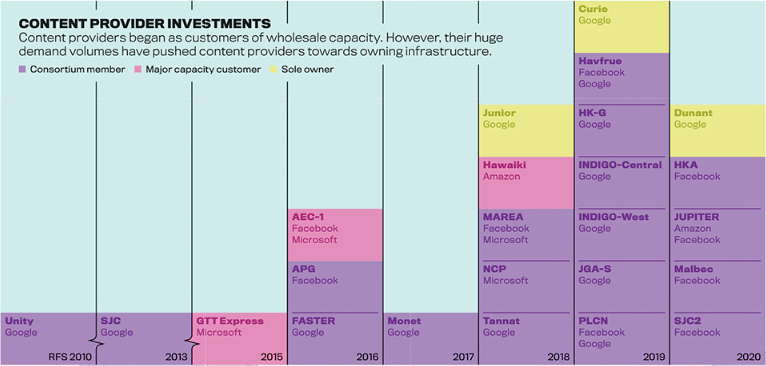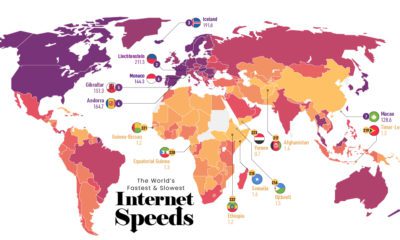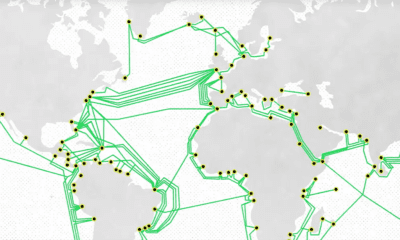Long gone are the days when images would load pixel row by pixel row. Now, even high-quality video is instantly accessible from almost everywhere. How did the internet get so fast? Because it’s moving at the speed of light.
The Information Superhighway
The miracle of modern fiber optics can be traced to a single man, Narinder Singh Kapany. The young physicist was skeptical when his professors asserted that light ‘always travels in a straight line’. His explorations into the behavior of light eventually led to the creation of fiber optics—essentially, beaming light through a thin glass tube. The next step to using fiber optics as a means of communication was lowering the cable’s attenuation rate. Throughout the 1960-70s, companies made gains in manufacturing, reducing the number of impurities and allowing light to cross great distances without a dramatic decrease in signal intensity. By the mid-1980s, long distance fiber optic cables had finally reached the feasibility stage.
Crossing the Pond
The first intercontinental fiber optic cable was strung across the floor of the Atlantic Ocean in 1988. The cable—known as TAT-8*—was spearheaded by three companies; AT&T, France Télécom, and British Telecom. The cable was able to carry the equivalent of 40,000 telephone channels, a ten-fold increase over its galvanic predecessor, TAT-7. Once the kinks of the new cable were worked out, the floodgates were open. During the course of the 1990s, many more cables hit the ocean floor. By the dawn of the new millennium, every populated continent on Earth was connected by fiber optic cables. The physical network of the internet was beginning to take shape. As today’s video from ESRI shows, the early 2000s saw a boom in undersea cable development, reflecting the uptick in internet usage around globe. In 2001 alone, eight new cables connected North America and Europe. From 2016-2020, over 100 new cables were laid with an estimated value of $14 billion. Now, even the most remote Polynesian islands have access to high-speed internet thanks to undersea cables. *TAT-8 does not appear in the video above as it was retired in 2002.
The Shifting Nature of Cable Construction
Even though nearly every corner of the globe is now physically connected, the rate of cable construction is not slowing down. This is due to the increasing capacity of new cables and our appetite for high-quality video content. New cables are so efficient that the majority of potential capacity along major cable routes will come from cables that are less than five years old. Traditionally, a consortium of telecom companies or governments would fund cable construction, but tech companies are increasingly funding their own submarine cable networks.
Source These three companies now own 63,605 miles of submarine cable. While laying cable is a costly endeavor, it’s necessary to meet surging demand—content providers’ share of data transmission skyrocketed from around 8% to nearly 40% over the past decade.
A Bright Future for Dark Fiber
At the same time, more aging cables will be taken offline. Even though signals are no longer traveling through this network of “dark fiber”, it’s still being put to productive use. It turns out that undersea telecom cables make a very effective seismic network, helping researchers study offshore earthquakes and the geologic structures on the ocean floor. on But fast forward to the end of last week, and SVB was shuttered by regulators after a panic-induced bank run. So, how exactly did this happen? We dig in below.
Road to a Bank Run
SVB and its customers generally thrived during the low interest rate era, but as rates rose, SVB found itself more exposed to risk than a typical bank. Even so, at the end of 2022, the bank’s balance sheet showed no cause for alarm.
As well, the bank was viewed positively in a number of places. Most Wall Street analyst ratings were overwhelmingly positive on the bank’s stock, and Forbes had just added the bank to its Financial All-Stars list. Outward signs of trouble emerged on Wednesday, March 8th, when SVB surprised investors with news that the bank needed to raise more than $2 billion to shore up its balance sheet. The reaction from prominent venture capitalists was not positive, with Coatue Management, Union Square Ventures, and Peter Thiel’s Founders Fund moving to limit exposure to the 40-year-old bank. The influence of these firms is believed to have added fuel to the fire, and a bank run ensued. Also influencing decision making was the fact that SVB had the highest percentage of uninsured domestic deposits of all big banks. These totaled nearly $152 billion, or about 97% of all deposits. By the end of the day, customers had tried to withdraw $42 billion in deposits.
What Triggered the SVB Collapse?
While the collapse of SVB took place over the course of 44 hours, its roots trace back to the early pandemic years. In 2021, U.S. venture capital-backed companies raised a record $330 billion—double the amount seen in 2020. At the time, interest rates were at rock-bottom levels to help buoy the economy. Matt Levine sums up the situation well: “When interest rates are low everywhere, a dollar in 20 years is about as good as a dollar today, so a startup whose business model is “we will lose money for a decade building artificial intelligence, and then rake in lots of money in the far future” sounds pretty good. When interest rates are higher, a dollar today is better than a dollar tomorrow, so investors want cash flows. When interest rates were low for a long time, and suddenly become high, all the money that was rushing to your customers is suddenly cut off.” Source: Pitchbook Why is this important? During this time, SVB received billions of dollars from these venture-backed clients. In one year alone, their deposits increased 100%. They took these funds and invested them in longer-term bonds. As a result, this created a dangerous trap as the company expected rates would remain low. During this time, SVB invested in bonds at the top of the market. As interest rates rose higher and bond prices declined, SVB started taking major losses on their long-term bond holdings.
Losses Fueling a Liquidity Crunch
When SVB reported its fourth quarter results in early 2023, Moody’s Investor Service, a credit rating agency took notice. In early March, it said that SVB was at high risk for a downgrade due to its significant unrealized losses. In response, SVB looked to sell $2 billion of its investments at a loss to help boost liquidity for its struggling balance sheet. Soon, more hedge funds and venture investors realized SVB could be on thin ice. Depositors withdrew funds in droves, spurring a liquidity squeeze and prompting California regulators and the FDIC to step in and shut down the bank.
What Happens Now?
While much of SVB’s activity was focused on the tech sector, the bank’s shocking collapse has rattled a financial sector that is already on edge.
The four biggest U.S. banks lost a combined $52 billion the day before the SVB collapse. On Friday, other banking stocks saw double-digit drops, including Signature Bank (-23%), First Republic (-15%), and Silvergate Capital (-11%).
Source: Morningstar Direct. *Represents March 9 data, trading halted on March 10.
When the dust settles, it’s hard to predict the ripple effects that will emerge from this dramatic event. For investors, the Secretary of the Treasury Janet Yellen announced confidence in the banking system remaining resilient, noting that regulators have the proper tools in response to the issue.
But others have seen trouble brewing as far back as 2020 (or earlier) when commercial banking assets were skyrocketing and banks were buying bonds when rates were low.






